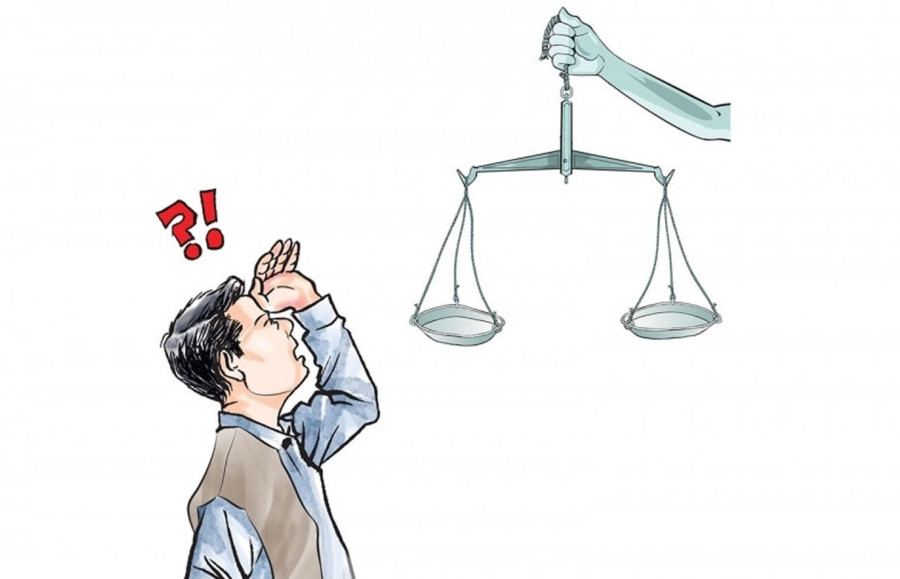Columns
Battling the court backlogs
The judiciary’s failure to deliver justice promptly is tantamount to denying justice altogether.
Udayan Regmi
Nepal’s judiciary has had a reputation for being a sturdy pillar advocating the protection and promotion of democratic values and the fundamental rights of citizens. The primary responsibility of the judiciary is to interpret and uphold the constitution and other legislation. However, a stack of unresolved cases and the inability of the judiciary to settle the disputes have frustrated the citizens. As of July 16, 2023, the Supreme Court had 28,434 pending cases. Of these, 15,149 cases are over two years old, and 4,168 cases are lingering for over five years. These statistics demonstrate how the pending cases are overwhelming Nepal’s courts and significantly hindering justice, raising concerns about the integrity of the whole judicial system.
Challenges of judiciary
The judiciary’s image is tarnished because it struggles to deliver prompt judgments. The first and foremost challenge is its reluctance to embrace information technology for efficient case management, which has created a ground for corruption, unchecked employee activity and duplication of efforts within the system. Similarly, appointing judges across all levels of the judiciary is another significant bottleneck in the decision-making process. Nepal’s constitution stipulates 20 judges for the Supreme Court, but only 14 are serving right now. Similar vacancies plague our District and High Courts, with 39 and 55 seats vacant for district and high court judges. Although the judges for all courts have already been forwarded, they are yet to be finalised, with political interference further complicating these appointments.
Third, the composition of the benches also lacks specialisation. The cases are assigned randomly, with no consideration of the expertise in the relevant field. Such an indiscriminate approach results in unnecessary delays as the judges grapple with unfamiliar subject matter. Fourth, time management during court proceedings is a significant hurdle. In high-profile or complex cases, numerous lawyers prolong proceedings, impeding the timely delivery of justice. A system that allocates time to lawyers based on case type could expedite the process. Moreover, the inadequacy of preparation and resources, such as pleading notes, among lawyers further hampers efficient proceedings. Furthermore, the judiciary is the only institution in Nepal that remains closed for 15 days during the Dashain festival, while other government offices close for only four to five days.
Fifth, the judiciary suffers from inadequate infrastructure, human resources and budgetary allocations. Poorly managed facilities and insufficient resources prolong administrative tasks, hampering the swift resolution of cases. Given the current state of affairs, it takes three months to finalise a decision. Budget constraints further aggravate the situation, hindering the judiciary’s daily operations.
Several intricate issues warrant careful consideration when expanding upon the challenges of increasing the court’s caseload. One of the noteworthy hurdles is relying on the Civil Service Commission for court staffing. This dependence creates a situation where the judiciary’s access to essential resources becomes contingent on a bureaucratic entity’s decision-making processes. The judiciary is positioned in such a way that it must rely on external authorities to determine its human resource requirements, thereby limiting its ability to independently assess and respond to its needs effectively.
Supreme Court’s jurisdiction extends over a broad spectrum of cases, including adjudicating various writ petitions. While the High Court also holds jurisdiction over writ petitions, legal practitioners are often inclined to approach the Supreme Court due to its perceived authority and specialised expertise. This prevailing tendency towards centralisation inadvertently exacerbates the workload of the Supreme Court and challenges efficient caseload management. Judges of the Supreme Court often find themselves appointed as heads of various committees for research purposes. While this signifies their commendable expertise, it diverts their attention from their primary judicial duties, contributing to an already burdensome caseload.
Furthermore, the general practice of transferring judges across various tiers of the court system is often random and unpredictable, posing a substantial challenge, particularly for judges in the lower tiers of the courts. The lack of clarity regarding their tenure or potential transfers may affect the motivation to address and reduce the caseload within their respective courts proactively. This hampers their ability to render timely justice and maintain optimal court efficiency.
Addressing the challenges
The challenges associated with increasing the courts’ caseload are multifaceted and intricate. They encompass issues related to resource allocation, centralisation of jurisdiction, diversion of judicial expertise and the unpredictability of judge transfers. Addressing these challenges necessitates a comprehensive and thoughtful approach aimed at enhancing the judiciary’s capacity to efficiently manage its caseload while ensuring the timely and effective administration of justice. These challenges have led to a decline in public perception of the judiciary. Citizens once looked at this institution as their last bastion of hope for justice; their sentiments have shifted over time. Many now perceive it as one of the most corrupt institutions in Nepal, a perception fueled by mounting evidence. To restore faith in our judiciary, we must prioritise promptly clearing the backlog of cases. Failing to deliver justice on time is tantamount to denying justice altogether.
In our pursuit of a just and thriving democracy, addressing these challenges within our judiciary is imperative. Only through systematic reform and a commitment to efficiency can we rebuild the trust that has eroded and reaffirm the judiciary as the guardian of our democracy’s values.




 8.12°C Kathmandu
8.12°C Kathmandu















